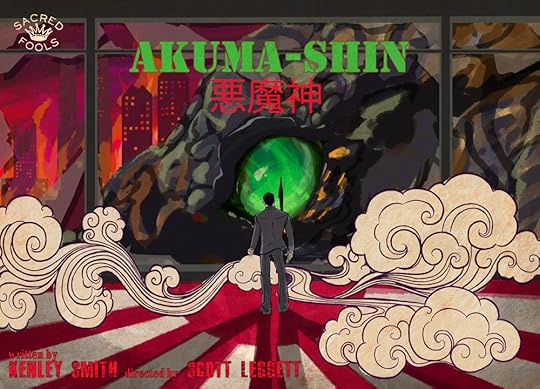Musing around Akuma-Shin (惡魔神), a play at FootLights Theater Community in LA
![[personal profile]](https://i.gr-assets.com/images/S/compressed.photo.goodreads.com/hostedimages/1491408111i/22407843.png) kaihangcheang
kaihangcheang

In his contribution to the recent anthology Flashpoints For Asian American Studies (2017), the critic Timothy Yu poses a provocative question: “has Asian American Studies failed?” On first glance, the answer to this provocation might seem to be simply and obviously “no,” or at least, “not yet,” but Yu argues that the recent upsurge in overt xenophobia in the US—and especially the open discussion of using internment as a strategy to contain and monitor Muslim refugees—suggests that Asian American critics are failing to build or sustain a social consensus against the sort of enforced racial incarceration that so traumatized the Asian American community. To take one prominent example of xenophobia, the mayor of Roanoke, Virginia, David A Bowers (2015) is on record expressing sympathy with President Roosevelt’s decision to incarcerate 110,000 Japanese Americans, and feels the need to do the same to Syrians in the US out of fear of ISIS. Reading claims like this, it’s difficult not to wonder if Americans have already forgotten the flawed logic that underwrote the internment of Japanese Americans: specifically, the conflation of Japanese American citizens and residents of the US with Japanese whose identified primarily with Japan. Or have most Americans simply never learned about the repercussions of internment? It’s difficult to know the precise roots of American ignorance or indifference on this subject, but Yu suggests that if the traumas of internment are to be avoided in the future, Asian American studies must become more relevant to the public. The histories and stories of oppressed Asian immigrants and their descendants have so much to tell us about the prospects for and dangers to marginalized immigrant groups today.
Asian American scholarship can provide a bridge between the lessons of the past and pressing questions of the present, but so can Asian American art. Kenley Smith’s Akuma-Shin is one such project. The play features rising Asian American actors including Reuben Uy (from the show Bosch), and Victor S. Chi (from Agents of S.H.I.E.L.D), and had a month-long run at LA’s Sacred Fools Theater Community, where I viewed it in April. Evoking Godzilla without directly calling “the monster” in the room by its commonly-known name, Akuma-Shin brings back memories of Cold-War-era xenophobia, materializing the affect in every characters’ terror of the monster, as the plot wanders through multiple temporal, geographical, and subjunctive dimensions from (post)WWII Japan, to the US in the Sixties, to 9-11 America.
Because of its expansive landscape, the play at times feel choppy; but the director and writer seem to have sought to make that choppiness a part of the play’s thematic presentation. The set included “side-stages” elevated on the left and right wings of the main stage, outfitted with colorful lighting and suspensive shadows to augment the drama. Overloaded by these stimuli, I left the theater still unpacking the dense symbolism at work in the play. What does the monster represent? What do the victims and the survivors in the play tell us about international fear by recounting the monster-induced apocalypse via the theatrical mediation of the talk show and the classroom?
The answers to these questions are, I think, directly related to the pedagogical values of Asian American history and culture. By concretizing fear in the popular figure of a Godzilla-like monster, a monster that brings out the personal demons, traumas, and failings in each of the characters of the play (Japanese and Americans included), Akuma-Shinuses popular culture to show how the fear of the Other can overwhelm the social imagination, leading to destructive vengeance and wide-spread collateral damage.
 comments
comments



